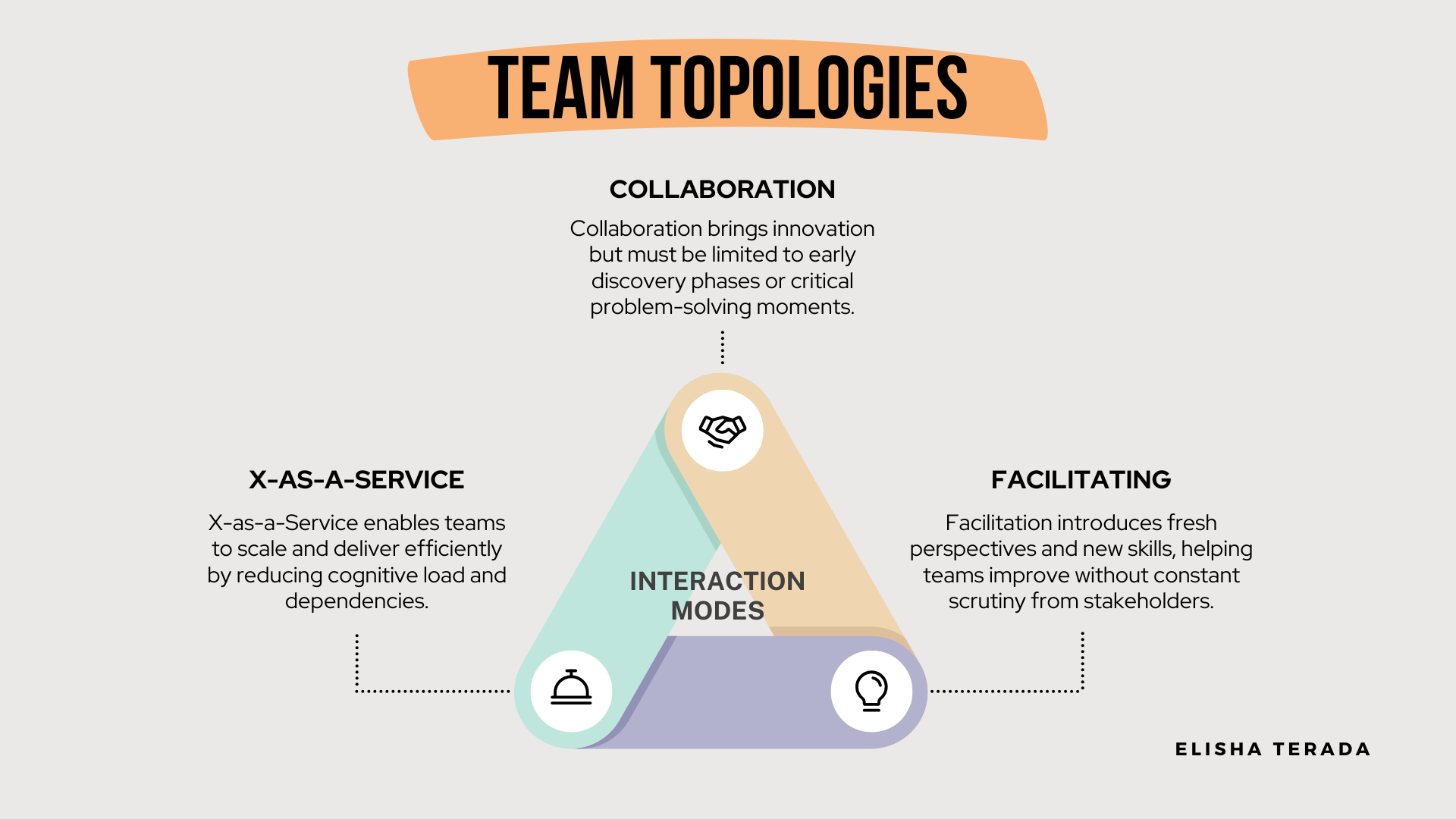Enhancing Software Team Dynamics with Team Topologies
Many software teams hit stagnation when excessive collaboration leads to burnout. By balancing focused collaboration for discovery, X-as-a-Service for execution, and facilitation for skill-building, leaders can empower teams to work autonomously.

Many software teams struggle to ship products because one role or perspective often dominates, overshadowing others. Stakeholders demand frequent updates, product managers over-manage, and engineers are bogged down by constant meetings—all in the name of alignment. Yet despite all the collaboration, projects stall, technical debt mounts, and innovation grinds to a halt. Sound familiar?
In this post, we’ll explore how Team Topologies by Matthew Skelton and Manuel Pais offers a framework to better balance team roles and processes. By aligning modes of interaction—Collaboration, X-as-a-Service, and Facilitation—teams can improve their delivery and foster productivity.
Understanding Team Topologies: Three Interaction Modes
At the heart of Team Topologies is the idea that team interactions directly impact delivery outcomes. The framework identifies three key modes of interaction, each with its strengths and limitations:
- Collaboration Mode
- Teams work together closely to solve complex problems.
- Best for early-stage projects or high-uncertainty initiatives requiring input from multiple areas.
- Challenge: High cognitive load as teams need deep knowledge of each other’s domains.
- X-as-a-Service Mode
- One team provides a well-defined service that others consume, such as an API.
- Ideal for autonomous operation and reducing dependencies between teams.
- Challenge: Reducing interaction can slow down innovation by limiting cross-team communication.
- Facilitation Mode
- A temporary interaction where one team supports another, often transferring knowledge or building new capabilities.
- Effective for mentoring, knowledge transfer, or addressing systemic challenges.
- Challenge: Facilitation must be time-bound to avoid dependency and foster independence.
Applying Team Topologies to Software Teams
In practice, these modes map to common roles and processes in software development:
- Collaboration Mode is often used in the discovery phase, where product managers, engineers, and designers work together to brainstorm, align on requirements, and generate solutions.
- X-as-a-Service Mode applies when teams own specific services like APIs. Product managers and stakeholders interact as consumers, requesting features without getting into technical details.
- Facilitation Mode can be seen when external experts (e.g., DevOps specialists) temporarily help a team adopt new tools or processes, such as during cloud migrations.
Balancing these modes is crucial. Over-collaboration can lead to burnout and inefficiency, while rigid service boundaries may limit creativity.
Overcoming Stagnation in Software Teams
Software teams often stagnate when decision-making slows, technical debt piles up, and roles become unclear. More meetings and reporting are often added in an attempt to regain control. However, relying too heavily on collaboration can lead to exhaustion without delivering results.
To break this cycle, leaders should adopt a phased approach, leveraging all three interaction modes:
- Start with Focused Collaboration (Short-Term)
- Begin with a short, high-intensity collaboration sprint (e.g., within a month) to align key stakeholders and teams. This phase should be time-bound to avoid collaboration fatigue. Once decisions are made, move on.
- Shift to X-as-a-Service Mode for Execution
- After alignment, switch to X-as-a-Service mode. Teams take ownership of specific services and work autonomously. This reduces the need for constant meetings, allowing teams to focus on delivery.
- Example: A backend team manages an API, with product updates provided only at key milestones, minimizing coordination overhead.
- Introduce Facilitation for Knowledge Transfer
- Bring in external experts or facilitators to tackle systemic issues like technical debt. Facilitation helps teams gain new skills or perspectives while maintaining independence.
- Example: A DevOps expert guides a team in automating deployments, eventually handing over full ownership of the process.
Achieving a Balance in Team Interactions
By balancing Collaboration, X-as-a-Service, and Facilitation modes, teams can remain aligned without feeling overwhelmed:
- Collaboration should spark innovation but be limited to key phases like early discovery.
- X-as-a-Service allows for scalable, independent delivery by reducing cognitive load.
- Facilitation brings in fresh perspectives and skills without micromanagement.
Used correctly, these modes create a rhythm that drives continuous improvement. Collaboration ignites ideas, X-as-a-Service enables smooth execution, and Facilitation fosters growth and knowledge transfer.
Practical Advice for Team Leaders
Leaders must move beyond constant meetings and realign team interactions for better outcomes. Here are a few tips:
- Limit collaboration—engage in short, intense sprints with clear deadlines to avoid burnout.
- Encourage autonomy—define clear ownership in X-as-a-Service mode to free teams from endless reporting.
- Use facilitation wisely—bring in external experts to unlock new skills without overwhelming your team.
Thought-Starters for Leaders:
- Are your teams stuck in endless meetings without shipping new features?
- What processes or services can shift to X-as-a-Service to free up team bandwidth?
- How often do you bring in external perspectives to challenge assumptions?
By strategically balancing collaboration, autonomy, and facilitation, leaders can unlock the full potential of their teams and foster long-term innovation. The key is to remain flexible and responsive, adjusting interaction modes as needed.
